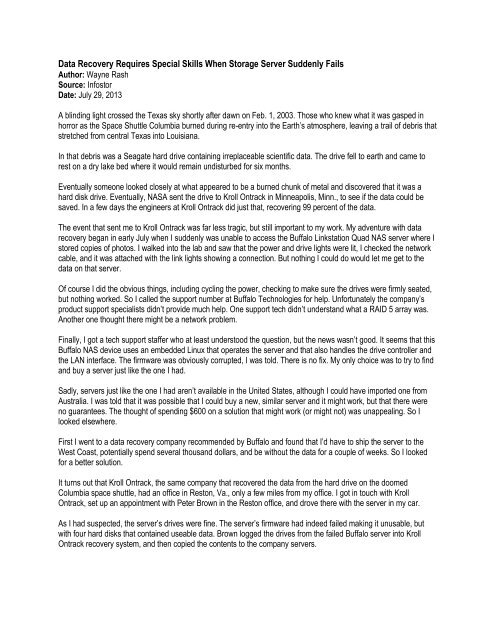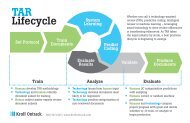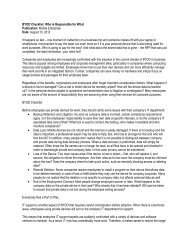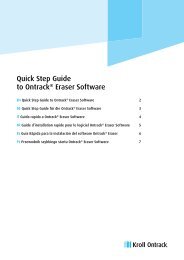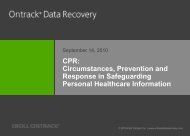Data Recovery Requires Special Skills When Storage ... - Kroll Ontrack
Data Recovery Requires Special Skills When Storage ... - Kroll Ontrack
Data Recovery Requires Special Skills When Storage ... - Kroll Ontrack
Create successful ePaper yourself
Turn your PDF publications into a flip-book with our unique Google optimized e-Paper software.
<strong>Data</strong> <strong>Recovery</strong> <strong>Requires</strong> <strong>Special</strong> <strong>Skills</strong> <strong>When</strong> <strong>Storage</strong> Server Suddenly FailsAuthor: Wayne RashSource: InfostorDate: July 29, 2013A blinding light crossed the Texas sky shortly after dawn on Feb. 1, 2003. Those who knew what it was gasped inhorror as the Space Shuttle Columbia burned during re-entry into the Earth’s atmosphere, leaving a trail of debris thatstretched from central Texas into Louisiana.In that debris was a Seagate hard drive containing irreplaceable scientific data. The drive fell to earth and came torest on a dry lake bed where it would remain undisturbed for six months.Eventually someone looked closely at what appeared to be a burned chunk of metal and discovered that it was ahard disk drive. Eventually, NASA sent the drive to <strong>Kroll</strong> <strong>Ontrack</strong> in Minneapolis, Minn., to see if the data could besaved. In a few days the engineers at <strong>Kroll</strong> <strong>Ontrack</strong> did just that, recovering 99 percent of the data.The event that sent me to <strong>Kroll</strong> <strong>Ontrack</strong> was far less tragic, but still important to my work. My adventure with datarecovery began in early July when I suddenly was unable to access the Buffalo Linkstation Quad NAS server where Istored copies of photos. I walked into the lab and saw that the power and drive lights were lit, I checked the networkcable, and it was attached with the link lights showing a connection. But nothing I could do would let me get to thedata on that server.Of course I did the obvious things, including cycling the power, checking to make sure the drives were firmly seated,but nothing worked. So I called the support number at Buffalo Technologies for help. Unfortunately the company’sproduct support specialists didn’t provide much help. One support tech didn’t understand what a RAID 5 array was.Another one thought there might be a network problem.Finally, I got a tech support staffer who at least understood the question, but the news wasn’t good. It seems that thisBuffalo NAS device uses an embedded Linux that operates the server and that also handles the drive controller andthe LAN interface. The firmware was obviously corrupted, I was told. There is no fix. My only choice was to try to findand buy a server just like the one I had.Sadly, servers just like the one I had aren’t available in the United States, although I could have imported one fromAustralia. I was told that it was possible that I could buy a new, similar server and it might work, but that there wereno guarantees. The thought of spending $600 on a solution that might work (or might not) was unappealing. So Ilooked elsewhere.First I went to a data recovery company recommended by Buffalo and found that I’d have to ship the server to theWest Coast, potentially spend several thousand dollars, and be without the data for a couple of weeks. So I lookedfor a better solution.It turns out that <strong>Kroll</strong> <strong>Ontrack</strong>, the same company that recovered the data from the hard drive on the doomedColumbia space shuttle, had an office in Reston, Va., only a few miles from my office. I got in touch with <strong>Kroll</strong><strong>Ontrack</strong>, set up an appointment with Peter Brown in the Reston office, and drove there with the server in my car.As I had suspected, the server’s drives were fine. The server’s firmware had indeed failed making it unusable, butwith four hard disks that contained useable data. Brown logged the drives from the failed Buffalo server into <strong>Kroll</strong><strong>Ontrack</strong> recovery system, and then copied the contents to the company servers.
Once he had done that, David Logue, senior lead data recovery engineer for <strong>Kroll</strong> <strong>Ontrack</strong>, reconstructed the RAIDarray as a virtual device. Once that was done, he was able to copy the reconstructed data to an external drive that Ipicked up at <strong>Kroll</strong> <strong>Ontrack</strong>’s Reston office a few days later.This sounds simple mainly because in my case it wasn’t a complex problem. All of my drives were intact andoperational; the data was stored in a standard format for Linux so there were no access problems. But it’s not alwaysthat simple.“We did stuff from [hurricane] Sandy last fall,” said Mike Burmeister, director of <strong>Recovery</strong> Operations for <strong>Kroll</strong><strong>Ontrack</strong>. “We had hard drives that had been underwater. We’ve had pretty good success.”Burmeister said that the company was able to recover all of the data from a storage area network in which adisgruntled former employee had gained access and erased all of the data and the backups. After recovering thedata, the <strong>Kroll</strong> Engineers were able to help the FBI track down the perpetrator.But much of the time the data recovery is fairly routine. A server dies, or there’s a fire or a flood and the databecomes unreachable. If companies have backups, then they’re safe. But with the decrease in the cost of storageand the resulting increase in the amount of stored data, backups aren’t always easy. Exacerbating that is the difficultyof storage backups even when they’re available. And not every cloud service has the ability to do fast backups ofvast quantities of data.Fortunately, a professionally run data recovery company such as <strong>Kroll</strong> <strong>Ontrack</strong> can get data back from a seeminglyunrecoverable place with remarkable success. But there is one thing to remember, as I was reminded by MikeBurmeister when we talked, and that is to make sure you store the recovered data in more than one place. You don’twant to lose it all over again when the next server fails.


